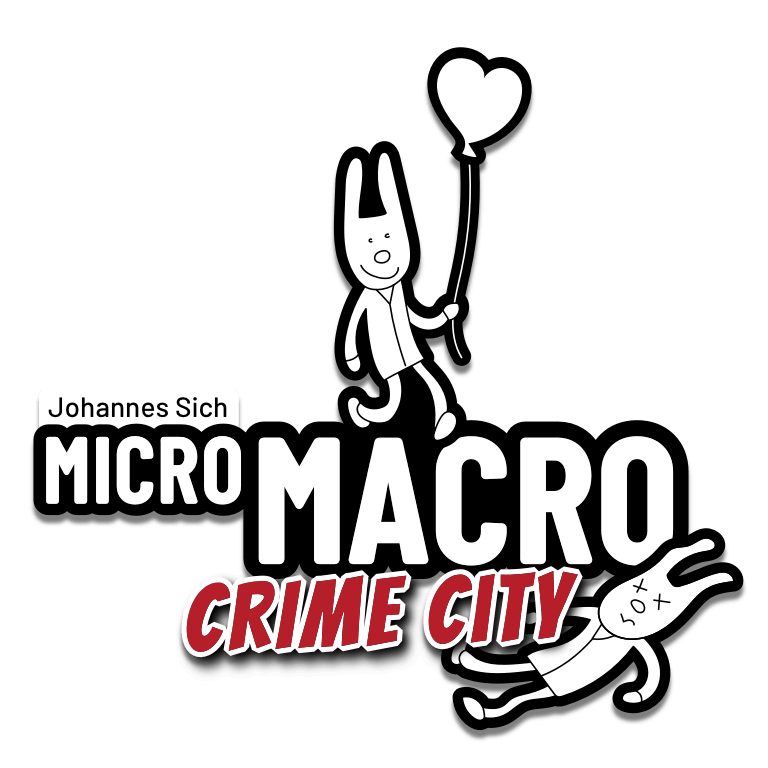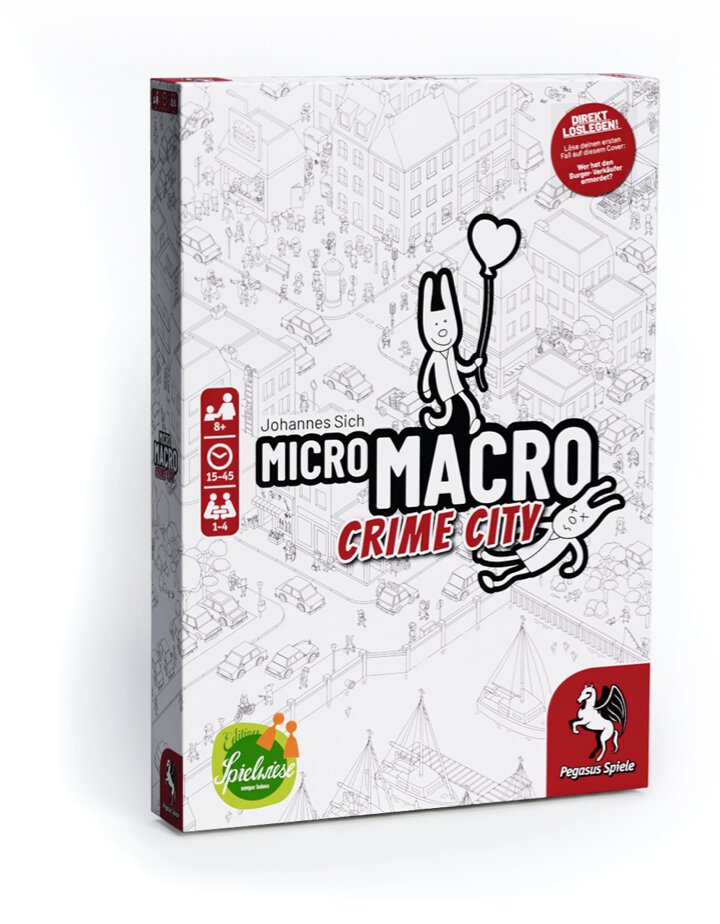MicroMacro: Crime City - RFY / WFY
Review copy provided by the publisher
Where was Waldo murdered in cold blood? I spy with my little eye (through the lens of an included magnifying glass) a tale of torrid love affairs and lives cut short.
In the years since our childhood innocence and fascination with visual puzzles led into other hobbies, it’s easy to forget the simple pleasure of looking for clues and hidden mysteries on a page. But don’t be deceived by the innocent look of MicroMacro: Crime City as this is not a kid-friendly romp through the city. It packs mature themes and visual violence onto a fold-out map. Chock-full of human error and fatal decisions, it’s bound to elicit childhood joy as your adult brain scans and parses every piece of information your eyes glean from the page.
MicroMacro: Crime City is a cooperative detective game. Players will have to work together to determine where the scenes of the crimes, the victims, the perpetrators, and then the evidence or motive necessary to close the case.
Designed by Johannes Sich and published by Pegasus Spiele, it’s a game not claiming the pretenses of excessive production or overly complex mechanics. It is a deduction game distilled down to a story-stuffed page and the keen eye of the investigators around the table.
Is it a game for you?
Overview
Gather round the table, detectives!
This is a city full of crime. Literally, they are happening and have happened all over the giant city map. And whoever is playing will have the job of finding it, analyzing it, and determining the circumstances of the crime before identifying who’s to blame.
There are 16 different cases in MicroMacro: Crime City, ranging from simple and straightforward to complex and nuanced. Every case in the game includes case cards with questions for players to answer, hints for them to consider, and a slowly unfolding narrative that describes how unfortunate individuals in this malevolent metropolis met their end. This isn’t a static map where everything is frozen in place. It’s a time capsule that includes the full breadth of these cases, captured in micro-moments for the macro reveal.
Finding the answer to one case card unlocks the next and then you’re able to progress through the case.
Theme
Everyone in the city is human… I think. But the sheer variety of facial shape, hair, and identifying features does make you wonder sometimes.
And a disturbing percentage of these people end up dead somewhere on the page. Much higher than you’d hope for in an urban environment that seems innocent enough at first.
Waldo’s not here. He wouldn’t want to be. Knowing how much he stands out, he’d probably wind up stabbed in a back alley or tossed off of a roof.
Here’s the lurid deal in this lethal city:
Crime happens.
But it doesn’t pay. You do that. So that you can solve cases.
Figure out what happened. Discover why.
Be lauded for your detective genius.
Start all over again with the next case.
Accessibility
There are 16 cases but they are not all the same level of complexity. There is actually a simple case on the outside of the game box that can teach you the game before you ever take off the shrink wrap.
And once you open everything up and get the game ready, an introductory case does the additional legwork of getting players accustomed to how a case works.
Beyond that, the other 15 cases gradually increase in difficulty until you’re left with multi-layered, nuanced stories that you have to track across the city map.
But at the end of the day, it’s an easy teach and an even easier play. Make sure the lighting in the room is good. Then pass around the magnifying glass and start searching! This is the kind of game that can interest gamers while also inviting others to the table that might normally balk at a board game.
Gameplay
You can play MicroMacro: Crime City at several different player counts, but for the purposes of standing at a table and looking at a map, it plays best with just two, so that each player isn’t crowding out the other. But you can take turns on different cases and find other solutions to make the experience inviting for however many people are there around the table. It’s up to you how you want to experience the crime-solving fun.
And that’s what you’re doing—solving crime. Each case starts with introductory text and an image of the central figure in the story (usually the victim). There might be some text or visual details that players should pay attention to as well because they can provide a direction for the investigation.
After the introductory card, the rest of the case takes place in numerical order. Every case card has a question and players cannot reveal the back side of the cards until they feel they’ve answered that question. If the question is answered, then players move onto the next card. If not, the player who looked allows the others to continue searching without spoiling the answer.
This process continues until players have worked through the whole case and solved it.
That’s all you really have to worry about. Examine the city map closely and follow the movements of the victims and the suspects until you have all of the answers you need.
Modes of Play
Beyond the traditional gameplay, there is a harder variant available for players to try if they feel up for a challenge. In the more punishing version of MicroMacro: Crime City, players will read just the introductory cards and then attempt to solve the entire case without the use of the additional cards. It’s a eye-straining obstacle course through the streets of the city and it will take some determined detectives to make it happen!
Innovation
I love that this game exists. I think it’s a great sign of the hobby’s breadth in terms of what is designed, produced, and published.
Taking the types of puzzles that many of us loved in our youth and creating something clever and interactive out of it is indicative of a board game industry that will continue to innovate, iterate, and bring new delights to the table.
A picture is not a thousand words here. It’s a thousand other pictures and dozens of stories. That’s just plain fun and even if the game doesn’t have long legs on it, it will please players for as long as it stays on the table.
Pricing
This is likely one of those purchases that you chalk up to paying for the experience rather than the replay value.
At just $30, though, it’s definitely worth the price and will hopefully be followed by additional cases and criminally fun productions.
Once a player has delved into all 16 cases, there won’t be much incentive to keep the game other than to keep it for friends and family who haven’t experienced it. And it would also be a great gift to pass on to others once you’ve extracted everything you can from its black-and-white illustrations.
MicroMacro: Crime City is…
Right for You!
Check out what the community thinks on BoardGameGeek.
Read the rules here.
Learn more at Pegasus Spiele.





